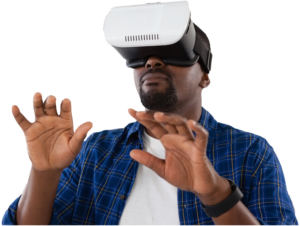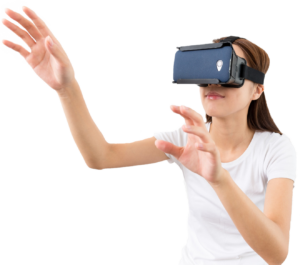Virtual Reality: The Future of Adult Learning
by Tony Ryals
I turn around as a student of mine, April, storms out of the classroom. This is the fourth night our GED® class has worked on fractions. We have tried every type of method, worksheet, and activity to reach the students. She finally returns. Her eyes are a bit glossy and she apologizes, “Mr. Tony, I am sorry. I just don’t understand fractions. I never have. Do you know how embarrassing it is to have a son in fourth grade and you can’t help him with fractions?” In her moment of vulnerability, she shared that she dropped out of high school at 15 and it was her dream to attend college to become an anthropologist. At that moment, I knew that all the skills I had would not break this lifelong barrier. I wondered what could be done to help other adult learners who may have moments like this.
Virtual reality (VR) is beginning to shift how adults in education learn. Not only has VR changed the scope of learning, but it is also building learner confidence and literacy. Let’s face it: we cannot escape technology. No matter our age, socioeconomic status, or location, we can see technology in our everyday lives. Just think of our mobile devices: according to the Pew Research Center’s Mobile Fact Sheet (2018), 95% of Americans own a cell phone of some kind. 94% of adults ages 18-29, 89% of adults ages 30-49, and 73% of adults ages 50-64 own a smartphone. These statistics remain in the upper 90th percentile in urban, suburban, and rural demographics. Technology is part of our everyday lives. Our smartphones are more than just Facebook and selfie depositories; they can be used to advance adult learners.
Gone are the days when learning could only take place between four walls. As technology advances, the educational field, especially adult education, has had some reservations about moving too fast. Perhaps the old adage, “if it isn’t broken, don’t fix it” still rings true among some adult education programs. However, the spectrum of learning has completely changed. Learning today is more than just notetaking, lectures, and textbooks. Learning has become engaging, creative, and forward-thinking. VR is a resource that may be able to reach the students who feel all hope is lost or fear traditional learning environments. It may help build confidence as a student works and learns on their own. Technology resources are more than just a fun way to learn; they provide pathways that can lead students to success and achieving their goals.
As an educator in this field, buy-in is extremely important. As a GED® instructor, I see how students come and go; they are passionate about completing their education and, then, life happens. VR may be the answer to these issues. Learning can take place outside of school buildings. Enrollment may increase as VR learning platforms are created to allow students to learn on the go. Blended learning opportunities can allow adult learners to continue their education, even when “life happens.”An Education Week research round-up cites Julia Freeland, a research fellow at the Clayton Christensen Institute for Disruptive Innovation, on the need to think beyond the “average” student in evaluating technology integration. “The whole power of blended learning … lies in its ability to personalize education to meet individual students’ needs” (Davis, 2015). VR has the ability to meet adult learners where they are and lead students on a personal path of success.
Place the headset over your eyes, slide your smartphone safely into a compartment, and enter into your own virtual world of learning.
Virtual Speech and Engage are just a few platforms that are leading the VR cavalry in adult education. Virtual Speech is an immersive learning platform that not only educates, but builds confidence. Virtual Speech allows the user, through their smartphone, to enter into a unique VR experience through a headset. Headsets range from $14.99 to $99.99; place the headset over your eyes, slide your smartphone safely into a compartment, and enter into your own virtual world of learning. This virtual world is not like a regular computer game; you are immersed into a virtual learning simulation, able to grab things and move around in a world that is different from your own. Specifically, with Virtual Speech, learners retrained in leadership, job interviewing skills, and even public speaking. Virtual Speech allows these immersive learning simulations to be accessible through a smartphone, anywhere.
Engage is a VR platform that allows 30 students to virtually interact and earn with one another. A teacher can record lesson and provide virtual and immersive elements to a class. For instance, if you are teaching about the solar system, learners can virtually pick up different planets, explore the surface of Mars, or see the rings of Saturn. he great part of this software is that these lessons are created for you, or you can request lessons that fit the needs of your students. assign a science project where students mix chemicals, or take the students on a virtual field trip through an erupting volcano, all while you moderate what is happening every step of the way. As a teacher, you have the opportunity to think creatively about how to design a lesson that will have the best impact n your learners. Engage makes the set-up process very easy for teachers:
- Choose a design for your classroom.
- Add interactive elements that go along with your lesson (i.e., a black-board where a student can work on math problems).
- Record your lesson.
- Observe students in real-time or watch the recorded version at a later time.
These immersive learning classes engage adult learners, allowing them to explore elements of a lesson that may not be accessible in a traditional adult learning setting.
While VR platforms are fun and engaging, they are also a solution to a problem. The life of an adult learner is busy, and getting an education should not feel like a burden. VR is an investment in providing more opportunities to learn. As a teacher, you want to feel a sense of ownership over your lessons and curriculum. Virtual Speech and Engage are useful platforms that allow teachers to still have this ownership and to check in on student progress. VR is not a way to take over the field of adult education: it adds to the options available to meet an adult learner’s needs. After a week of spending time learning virtually, students might write a report on what they learned and present it during a face-to-face class. Students could also complete VR lessons while on vacation or throughout the summer; VR learning can potentially fill the gaps where funding and resources fall short.

As an educator, you also want to reach every student, to see them achieve their goals and provide for their families. However, not all students learn at the same pace or in the same way. VR provides an option for students to work outside the classroom, at their own pace, at their own time. How amazing would it be if April was able to use VR technology as a hands-on way to learn fractions? She could manipulate pieces and parts of a whole or complete hands-on fraction drills that build her confidence. This resource could be the thing that helps break a barrier for her. She would then be able to sit at the kitchen table with her son and help him learn fractions.
Overall, VR offers unique possibilities for technology-integrated instruction. Most VR platforms offer support to educators on how to properly use the technology and provide the best learning experience for each student. The future of education will be driven by efforts to find more ways to provide access, engagement, buy-in, and convenience for all learners from all walks of life. Through technology, learning can take place at home, on a lunch break, or on the bus. While VR is still new in the field of education, the future looks very bright. The same smartphones that the majority of Americans hold in their hands are shaping how, when, and where learning can occur. Technology in education is not only creating unique ways of learning, but it is breaking down barriers for adult learners everywhere.
References
Davis, M. R. (2015, April 23). Blended learning research: The seven studies you need to know [Blog post]. Retrieved from http://blogs.edweek.org/edweek/ DigitalEducation/2015/04/blended_learning_ research_the.html?print=1
Pew Research Center (2018, February 5). Mobile fact sheet. Retrieved from http:// www.pewinternet.org/fact-sheet/mobile/
Tony Ryals is Workforce Support Specialist at the Virginia Adult Learning Resource Center. Tony holds an Ed.S. from Liberty University and an M.Ed. from Lesley University. Before he joined the staff at VALRC, Tony taught in the Boston Public School system.